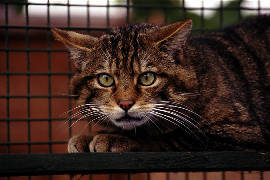Overview
 Order: Carnivora
Order: Carnivora
Family: Felidae
Species: Felis silvestris
IUCN Red List: UK Critically Endangered, Globally: Least Concern.
Distribution: Highlands of Scotland; possibly a few in the Scottish borders and Northumberland. Also Spain, Germany, Poland and parts of southern Europe.
Habitat: in Scotland inhabits remote forests, hill areas and grouse moors.
Description: resembles a domestic tabby but is slightly larger with longer, softer fur and broader head. Black or grey body stripes (a tabby is blotched). Bushy tail with a blunt, black, rounded tip (domestic cats' tails are longer and pointed).
Size: male measures about 90cm from nose to tail-tip; female slightly smaller.
Life-span: about 12 years.
Food: rabbits, hares, small rodents, birds and insects form the main diet; sometimes squirrels and deer fawns are taken.
The wild cat was once common over most of the British Isles, but it is now only found in Scotland and is under threat with an estimated 400 remaining outside captivity. Although it looks very much like a domestic tabby cat, the wild cat is very fierce and almost impossible to tame, even if brought up from a tiny kitten.
Read More: Wild cat Habits